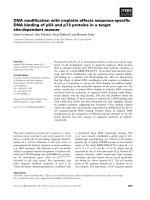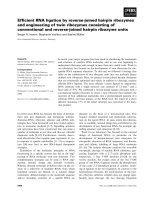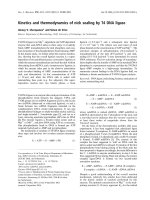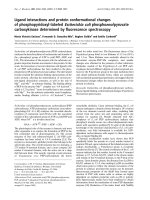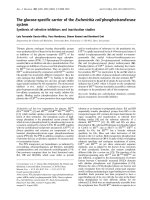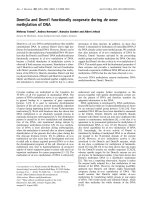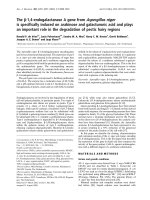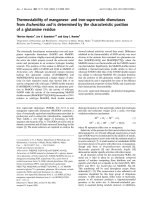Tài liệu Báo cáo Y học: DNA and RNA damage by Cu(II)-amikacin complex docx
Bạn đang xem bản rút gọn của tài liệu. Xem và tải ngay bản đầy đủ của tài liệu tại đây (342.83 KB, 10 trang )
DNA and RNA damage by Cu(II)-amikacin complex
Małgorzata Je
_
zzowska-Bojczuk
1
, Wojciech Szczepanik
1
, Wojciech Les
´
niak
1,
*, Jerzy Ciesiołka
2
,
Jan Wrzesin
´
ski
2
and Wojciech Bal
3
1
Faculty of Chemistry, University of Wrocław, Wrocław, Poland;
2
Institute of Bioorganic Chemistry, Polish Academy of Sciences,
Poznan
´
, Poland;
3
Institute of Biochemistry and Biophysics, Polish Academy of Sciences, Warsaw, Poland
The oxidation-promoting reactivity of copper(II) complex of
aminoglycosidic antibiotic amikacin [Cu(II)-Ami] in the
presence of hydrogen peroxide, was studied at pH 7.4, using
2¢-deoxyguanosine (dG), pBR322 plasmid DNA and yeast
tRNA
Phe
as target molecules. The mixtures of complex with
H
2
O
2
were found to be efficient oxidants, converting dG to
its 8-oxo derivative, generating strand breaks in plasmid
DNA and multiple cleavages in tRNA
Phe
.Thecomplex
underwent autooxidation as well, with amikacin hydroper-
oxides as likely major products. This reactivity pattern was
found to be due to a combination of metal-bound and free
hydroxyl radicals.
Keywords: copper(II) complexes; amikacin; 2¢-deoxyguano-
sine oxidation; plasmid DNA damage; tRNA cleavage.
Amikacin (Ami) is a semisynthetic aminoglycoside, a
derivative of kanamycin A, having the B1 amino group of
2-deoxystreptamine moiety modified by acylation with
4-amino-2-hydroxybutyric acid. Previous studies demon-
strated that Ami is a strong chelator for Cu(II) ions [1,2].
Cu(II) is coordinated at B ring, which is in contrast with
unsubstituted aminoglycosides, where terminal aminosugar
rings are involved in the binding [3–11]. In the presence of
H
2
O
2
the Cu(II)-Ami complex oxidizes 2¢-deoxyguanosine
to its 8-oxo derivative [1]. Recently we presented the
mechanism of such H
2
O
2
activation, which involves
generation of hydroxyl radicals [12].
Antimicrobial action of Ami and other aminoglycosides
is based on their interactions with ribosomal RNA [13] and
also with cytoplasmic membrane [14,15]. Aminoglycosides
also have severe toxic side-effects, on kidney and inner ear
[16,17]. Fe(II) complexation and generation of hydroxyl
radicals by another aminoglycoside, gentamicin has recently
been implicated in the mechanism of its toxicity [18,19].
Aminoglycosides themselves, including Ami, are redox-
inactive [12,20]. While intracellular copper is under very
tight control in bacterial cells, exerted by specific chaperone
proteins [21], extracellular copper in the human blood serum
is coordinated in part by, a variety of low molecular mass
ligands [22,23]. It is not controlled as tightly there, and is
elevated in some pathological conditions, including cancer
and inflammation [24]. It is not unlikely that some copper
may be transferred to Ami, e.g. during treatment of sepsis.
This physiological state also involves increased generation
of hydrogen peroxide and oxygen radical species [25]. The
ability of Cu(II) complexes of other aminoglycosides to
cleave DNA and RNA was shown recently [11,26,27]. Here
we present the interactions of Cu(II)-Ami with oxidation-
susceptible biomolecules: 2¢-deoxyguanosine (dG), pBR322
plasmid DNA and yeast tRNA
Phe
in both presence and
absence of hydrogen peroxide, as well as the complex
autooxidation. Some of these reactions may play a role in
toxic effects of amikacin.
EXPERIMENTAL PROCEDURES
Materials
Amikacin and Tris buffer were obtained from Fluka
(Buchs, Switzerland); CuCl
2
, methanol, 2¢-deoxyguano-
sine (dG), H
2
O
2
, Chelex 100 resin, EDTA, and sodium
and potassium phosphates were purchased from Sigma
Chemical Co. (St Louis, MO). The reference sample of
7,8-dihydro-8-oxo-2¢-deoxyguanosine (8-oxo-dG) was syn-
thesized and purified by HPLC according to a published
procedure [28]. Low EEO agarose was purchased from
AppliChem (Darmstadt, Germany). Bromophenol blue
and glycerol were obtained from POCH (Gliwice,
Poland). The plasmid pBR322 was isolated by
J. Zakrzewska-Czewin
˜
ska (Institute of Immunology and
Experimental Therapy, Polish Academy of Sciences,
Wrocław, Poland). Bacterial alkaline phosphatase and
T4 polynucleotide kinase were from MBI Fermentas
(Vilnius, Lithuania) [c-
32
P]ATP was purchased from ICN
(Costa Mesa, CA, USA). Electrophoretic reagents: boric
acid, acrylamide, bis-acrylamide and urea were obtained
from Serva (Heidelberg, Germany).
Decomposition of dG and formation of 8-oxo-dG
Solutions of dG (50 l
M
)in50m
M
sodium phosphate
buffer, pH 7.4, were incubated in triplicate for 24 h at 25 °C
or 37 °C in the presence of combinations of Ami, Cu(II)
Correspondence to M. Je_zzowska-Bojczuk, Faculty of Chemistry,
University of Wrocław, F. Joliot-Curie 14, 50–383 Wrocław, Poland.
Fax: + 48 71 3282 348, Tel.: + 48 71 3757 281,
E-mail:
Abbreviations: Ami, amikacin; Cu(II)-Ami, cupric complex of
amikacin; dG, 2¢-deoxyguanosine; 8-oxo-dG, 7,8-dihydro-8-oxo-2¢-
deoxyguanosine; ESI, electrospray ionization; MS/MS, tandem mass
spectrometry; D, dihydrouridine; Y, wybutosine.
*Present address: Kriesge Hearing Research Institute, Ann Arbor,
MI, USA.
(Received 10 June 2002, revised 5 September 2002,
accepted 16 September 2002)
Eur. J. Biochem. 269, 5547–5556 (2002) Ó FEBS 2002 doi:10.1046/j.1432-1033.2002.03260.x
(0 or 50 l
M
)andH
2
O
2
(0.5 m
M
). At intervals, small
aliquots were removed from the incubating mixtures and
analyzed by HPLC without any additional pretreatment on
a HP 1100 system (Hewlett-Packard, Palo Alto, CA, USA)
with a Nucleosil 100 C
18
column (4.6 mm · 25 cm), using
UV detection at 254 nm. The mobile phase was 50 m
M
KH
2
PO
4
solution in 12% aqueous methanol. Results were
quantified with the use of standard solutions containing
known amounts of dG and 8-oxo-dG.
Mass spectrometry (MS)
The mass spectra were obtained with a Finnigan Mat TSQ
700 instrument (Thermo-Finnigan, Bremen, Germany),
using the ESI (electro-spray ionization) technique with N
2
as carrier gas, and flow of 2 lLÆmin
)1
. Four kinds of
samples were investigated at pH 7.4, adjusted with acetic
acid and ammonium carbonate: free Ami, Ami-H
2
O
2
,
Cu(II)-Ami and Cu(II)-Ami-H
2
O
2
. All samples were pre-
pared as water solutions and incubated at 37 °Cfor5,20
and 40 min. Then methanol was added to a final concen-
tration of 50%, in order to decrease surface tension during
sample evaporation. Final sample concentrations were: Ami
and Cu(II), 0.5 m
M
;H
2
O
2
,2.5m
M
. Further analysis of key
peaks was carried out using tandem MS (MS/MS) experi-
ments, using helium as a collision gas. Its pressure was
adjusted so that the parent ion intensity was 45% of its
initial abundance.
DNA strand break analysis
The ability of Cu(II)-Ami to induce strand breaks in
plasmid DNA in the absence and presence of H
2
O
2
was
tested with the use of pBR322 plasmid. Samples contained
15 l
M
DNA in 50 m
M
sodium phosphate buffer (pH 7.4)
and combinations of amikacin, CuCl
2
and H
2
O
2
.The
concentrations of these reagents were as follows: Ami, 0 or
50 l
M
; Cu(II) 0 or 50 l
M
,H
2
O
2
,0,0.5,5or50l
M
.After
1hincubationsat37°C, reaction mixtures (20 lL) were
mixedwith4lL of loading buffer (bromophenol blue in
30% glycerol) and loaded on 1% agarose gels, containing
ethidium bromide, in Tris/borate/EDTA buffer (90 m
M
Tris/borate, 20 m
M
EDTA, pH 8.0). Gel electrophoresis
was carried out at constant voltage of 100 V (4 VÆcm
)1
), for
20 min. As control for double strand breaks, reference
plasmid samples were linearized with XhoI endonuclease.
The procedure used in kinetic experiments was similar, with
the use of Ami and H
2
O
2
,Cu(II)andH
2
O
2
and Cu(II)-Ami
and H
2
O
2
(each 50 l
M
), incubated at 37 °C for time periods
varied between 5 and 95 min, typically with 10 min
intervals. The gels were photographed and processed with
a Digital Imaging System (Syngen Biotech, Wrocław,
Poland).
Isolation of yeast tRNA
Phe
Yeast tRNA
Phe
of specific phenylalanine acceptance
1200–1400 pmol per A
260
unit was prepared from crude
baker’s yeast tRNA by standard column chromatography
procedures including benzoylated DEAE-cellulose and
Sepharose-4B (Pharmacia, Sweden). Final purification was
carried out by HPLC on TSK-gel DEAE 2SW column
(Toyo Soda, Japan).
Labeling of tRNA
Phe
Yeast tRNA
Phe
was dephosphorylated with bacterial alka-
line phosphatase and subsequently 5¢-end-labeled with
[c-
32
P]ATP and polynucleotide kinase. The tRNA was
purified on a denaturing 12.5% polyacrylamide gel, located
by autoradiography, excised and eluted from the gel with
the 0.3
M
potassium acetate buffer, pH 5.1, containing
1m
M
EDTA and 0.1% SDS. The eluted tRNA
Phe
was
precipitated with ethanol, dissolved in water and stored at
)20 °Cbeforeuse.
TRNA
Phe
cleavage analysis
Prior to the reaction, the
32
P labeled tRNA
Phe
was
supplemented with carrier tRNA
Phe
to the final RNA
concentration of 1 l
M
and subjected to denaturation/
renaturation procedure by heating the samples at 65 °C
for 2 min and slow cooling to 25 °C. Cleavage reactions
induced by Ami and Cu(II)-Ami complexes (1–100 l
M
)
were performed in 10 m
M
sodium phosphate buffer at
pH 7.4, in the absence or presence of H
2
O
2
(50 or 100 l
M
).
Further details of the reaction conditions are specified
in figure legends. All reactions were stopped by mixing
with equal volume of 8
M
urea/dyes/20 m
M
EDTA solu-
tion and loaded on a 15% polyacrylamide, 7
M
urea gel.
Electrophoresis was carried out at 1500 V for 3 h,
followed by autoradiography at )80 °C with an intensifying
screen.
In order to assign the cleavage sites, products of cleavage
reaction were run along with the products of alkaline
degradation and limited T
1
nuclease digestion of the same
tRNA
Phe
. The alkaline hydrolysis ladder was generated by
incubation of
32
PlabeledtRNA
Phe
with 5 volumes of
formamide in boiling water for 10 min. Partial T
1
nuclease
digestion was performed in denaturing conditions (50 m
M
sodium citrate, pH 4.5, 7
M
urea) with 0.1 unit of the
enzyme. The reaction mixture was incubated for 10 min at
50 °C.
RESULTS
Mass spectrometry of the Cu(II)-Ami-H
2
O
2
system
Figure 1 presents the molecule of Cu(II)-amikacin complex
with the possible places of breakage indicated, and Fig. 2
provides typical mass spectra for the antibiotic and its
complex both in presence and absence of hydrogen perox-
ide. According to the data presented in Table 1, the solution
containing Ami alone can be characterized by signals at m/z
of 587 and 294 (predominant), corresponding to single- and
double-charged Ami ions, respectively. Several peaks of low
intensity were also observed, resulting from dimerization
and fragmentation of the Ami molecule during the ioniza-
tion process. No differences were observed between the
mass-spectra of the samples of Ami and Ami + H
2
O
2
.
Detection of the signals at m/z of 647 and 324 in the
Cu(II) + Ami samples (Cu(II)-Ami complex ions, carrying
charges of +1 and +2, respectively) confirmed the presence
of 1 : 1 complexes in solution at pH 7.4. New peaks were
also seen in the high m/z region, at m/z of 1232 and 1294.
They can be assigned to single-charged molecules of Cu(II)-
Ami
2
and Cu(II)
2-
Ami
2
, respectively. Also, two additional
5548 M. Je_zzowska-Bojczuk et al. (Eur. J. Biochem. 269) Ó FEBS 2002
peaks at m/z 710 and 355 appeared in the spectrum,
suggesting the formation of a Cu(II)
2
Ami complex. The
signal at m/z of 385 belongs to a complex decomposition
product.
The samples consisting of Cu(II), amikacin and H
2
O
2
gave signal-rich mass-spectra. There were no qualitative
differences between the samples at various incubation times.
Novel, high intensity signals at m/z values of 617, 600, 308
and 300 indicate the formation of Ami-oxygen adducts
(single and double-protonated Ami-O and Ami-O
2
mole-
cules). Another set of weaker signals, at m/z values of 679,
662, 340 and 331 likely represents Cu(II) complexes of these
adducts (see Table 1). Also, many low intensity peaks
appeared in the m/z region of 439–512. In order to assign
them and to gain better understanding of the oxidation
products, the MS/MS experiments were performed for
peaks at m/z 586 (Ami), 600 (Ami + O) and 617
(Ami + 2O). The results are presented in Table 2. Only
the peaks with m/z higher than c. 400 were resolved to a
degree allowing assignments.
Oxidation of 2¢-deoxyguanosine
We previously found that Cu(II)-Ami has a particular
ability to oxidize dG to 8-oxo-dG [1]. The kinetics of this
process at 37 °C was investigated here. The reactions of
decomposition of dG and formation of 8-oxo-dG are
illustrated on Fig. 3A and B, respectively. The shapes of
kinetic curves indicate that both these reactions are in the
second-order mode at times longer than 10 min. Still, the
kinetic constants of first-order reactions could be calculated
from the first 10 min, to be 1.836 ± 0.039 · 10
)3
min
)1
for
dG decomposition and 2.084 ± 0.061 · 10
)1
min
)1
for
8-oxo-dG formation. For comparison with previous experi-
ments [1], data at 24 h were also recorded for 25 and 37 °C,
and were found to fall within the same ranges (data not
shown). The efficacy of dG conversion into 8-oxo-dG was
50% for 25 °Cand 25% for 37 °C.
Interaction with pBR322 plasmid
Figure 4 presents the strand break assays of pBR322,
performed by means of agarose gel electrophoresis. The
plasmid can be detected in one of three forms: supercoiled
(I), nicked/relaxed (II) or linear (III). Part A of Fig. 4 shows
DNA cleavage by Cu(II)-Ami complex both in the presence
and absence of H
2
O
2
(50 l
M
), part B – in two different,
lower concentrations of H
2
O
2
:5and0.5l
M
.Inthefirst
experiment (part A) the samples, dissolved in 50 m
M
phosphate buffer of pH 7.4, contained combinations of
50 l
M
Cu(II), Ami and H
2
O
2
. At these conditions 55% of
Cu(II) was present as CuHAmi, 35% as CuAmi, and the
remaining 10% as Cu(II) aqua ion [1].
Cu(II) alone (lane 7) and H
2
O
2
alone (lane 3) increased
the amount of form (II), but only marginally under those
conditions. The presence of Ami alone (lane 8), with Cu(II)
(lane 9) or with H
2
O
2
(lane 5) resulted in a higher conversion
to form (II). The combination of Cu(II) and H
2
O
2
(lane 4)
was more active, yielding mostly form (II) and also a trace
of linear form (III), while the mixture of all three compo-
nents (the Cu(II)-Ami complex in the presence of H
2
O
2
(lane 6) destroyed form (I) completely in these conditions,
yielding 2/3 of form (II) and 1/3 of form (III).
Another effect, seen specifically for samples containing
Ami, was a faint smear between the well and the band of
form II. It had the highest intensity for Cu(II)-free samples,
both with and without H
2
O
2
(lanes 5 and 8).
Having established the requirement of H
2
O
2
presence for
complex-mediated DNA cleavage, we checked its reactivity
at H
2
O
2
concentrations 10 and hundred times lower than
the initial 50 l
M
(Fig. 4 part B). The effects of lower
concentrations of H
2
O
2
alone (lanes 3 and 7) were at the
background level. The activity of the mixture of Ami and
H
2
O
2
was maintained at the constant level, independently of
H
2
O
2
concentration. The activity of the Cu(II) and H
2
O
2
combination was found to be roughly proportional to the
logarithm of H
2
O
2
concentration. The same can be
estimated for the Cu(II)-Ami-H
2
O
2
system, but at a higher
level of activity (lanes 6, 10).
Figure 5 present the kinetics of pBR322 cleavage with
Ami + H
2
O
2
(part A), Cu(II) + H
2
O
2
(part B), and
Ami + Cu(II) + H
2
O
2
(part C) for incubation times
between 5 and 95 min. As clearly seen, Ami + H
2
O
2
did
not produce form (III), and the ratio of forms (I) and (II)
remained constant throughout the experiment. In the
presence of Cu(II) and the complex, the degradation process
proceeded from decomposition of form (I) (almost complete
at 90minincaseofCu(II)aquaionand 15 min for the
complex), through the relaxed form II, to the linear form
III. In the Cu(II) + H
2
O
2
system, the amount of form II
increased during the duration of the experiment. Only for
the complex in the presence of hydrogen peroxide a further
degradation of both forms II and III was seen, to a smear of
short DNA fragments at times longer than 75 min.
Cleavage of yeast tRNA
Phe
induced by the
Cu(II)-Ami-H
2
O
2
system
Figure 6 shows the results of the strand-break assay of yeast
tRNA
Phe
in the presence of Ami, Cu(II)-Ami and the
Cu(II)-Ami-H
2
O
2
system, performed by means of poly-
acrylamide gel electrophoresis. Strikingly, in the presence of
Fig. 1. The schematic drawing of the Cu(II)-amikacin complex at
pH 7.4, with the sites of breakage indicated by ESI-MS and MS/MS
experiments. Arrows indicate the positions of breakages occurring in:
ligand molecule, in the absence of Cu(II), Þ; Cu(II)-Ami complex,
dottedarrow;inbothcases, fi .
Ó FEBS 2002 DNA and RNA damage by Cu(II) amikacin complex (Eur. J. Biochem. 269) 5549
Ami or Cu(II)-Ami highly specific cleavages occurred in the
anticodon loop, at Y37 (Fig. 7). These cleavages were
already observed with 5-fold molar excess of the antibiotic
or its copper(II) complex over tRNA
Phe
(lanes 4 and 9,
Fig. 6). The cleavage intensities increased with the concen-
tration of Ami and Cu(II)-Ami gradually, up to their
Fig. 2. Typical ESI-MS spectra of amikacin (A), its Cu(II) complex in the absence (B) and presence (C) of H
2
O
2
, as well as the MS/MS experiment on
the 587 m/z peak of amikacin (D).
5550 M. Je_zzowska-Bojczuk et al. (Eur. J. Biochem. 269) Ó FEBS 2002
50-fold molar excess (lanes 6, 7 and 11, 12, Fig. 6). This may
reflect a saturation effect of a tight antibiotic binding site.
Remarkably, the intensities of cleavages induced by free
Ami were slightly higher than those induced by its Cu(II)
complex.
Cleavages generated in the presence of Cu(II)-Ami-H
2
O
2
system were more numerous. Two cleavages with similar
intensities were observed at Y37 and A36 in the anticodon
loop (lanes 13–19, Fig. 6). Moreover, several cleavages
appeared also in the
D
-arm and their intensities increased
with H
2
O
2
concentration. The most prominent cleavage site
was localized at D17. The cleavages were weaker when the
Cu(II)-Ami-H
2
O
2
system was prepared one hour before
incubation with tRNA
Phe
(lanes 20 and 21, Fig. 6). In this
case, three major cleavages were observed, at Y37, A36 and
D17. It has to be noted, however, that the cleavage at D17
and in the D and anticodon loops occurred to some extent
already in the presence of 10 l
M
Cu(II) ions and 50 l
M
H
2
O
2
(data not shown). No cleavage was observed, however, at
Y37 in the absence of Ami or its Cu(II)-complex. Interest-
ingly, in another RNA molecule, the 3¢ product of the
genomic delta ribozyme, Ami and its Cu(II) complex
induced no specific cleavages. Only upon the addition of
H
2
O
2
several weak, nonspecific cleavages were found.
DISCUSSION
The initial target of oxidations promoted by Cu(II)-Ami is
the complexed aminoglycoside molecule (Fig. 1). Two kinds
of reactions were seen in the presence of Cu(II) and H
2
O
2
.
Fragmentations occurred predominantly at glycosidic
bonds between the rings and in the amide bond, linking
the aglycon to ring B (see arrows at Fig. 1 and spectra at
Fig. 2). Single and double oxygen additions were also seen
(Table 1). The fragmentation experiments performed on the
MS peaks of these adducts indicated their heterogeneity.
The majority of secondary peaks are identical to those
found for unmodified Ami (Table 2). This suggests that
labile forms, perhaps hydroperoxides, constitute the major-
ity of adducts, rather than products of hydroxylation. But
even those two peaks which could be assigned to stable
oxygen adducts (at m/z 528 and 436, Table 2) originate
from two different molecules – the former from an adduct
on one of the terminal rings and the latter from an adduct
on the aglycon chain. Such a lack of specificity is charac-
teristic for hydroxyl radical-like agents, and in this case can
be ascribed to the reactivity of an activated oxygen atom,
bound at the copper atom coordinated to the Ami molecule.
All the peaks with Cu(II)/Ami ratios different than 1 : 1 are
Table 1. Summary of the observed ESI-MS ions (m/z)atpH 7.4.Concentrations:Cu(II),Ami,0.5 m
M
and H
2
O
2
,2.5 m
M
. w, weak, i, intermediate,
s, strong signal; agl, aglycon chain; pep., aglycon chain broken at peptide bond; CO – NH, C
a
, aglycon chain broken between CO and C
a
.
Components of the solution m/z Assignment
Ami and Ami + H
2
O
2
1172
i
Ami
2
+H
+
587
s
Ami + H
+
425
i
Ami – ring A or C – OH + H
+
408
w
Ami – ring A or C with O (glycosidic bond) + H
+
315
w
Ami – ring A or C – agl. C
a
– 2OH + H
+
294
s
Ami + 2H
+
263
w
Ami – ring A – ring C + H
+
177
w
ring A or C with O (glycosidic bond) + H
+
162
w
ring A or C + H
+
147
w
ring A or C – NH
2
+H
+
Cu(II)-Ami 1294
w
Cu(II)
2
-Ami
2
+H
+
1232
i
Cu(II)-Ami
2
+H
+
710
w
Cu(II)
2
-Ami + H
+
647
i
Cu(II)-Ami + H
+
385
i
Cu(II)-Ami – ring A or C – agl. pep. + H
+
355
w
Cu(II)
2
-Ami + 2H
+
324
i
Cu(II)-Ami + 2H
+
and all the peaks seen for Ami
Cu(II)-Ami-H
2
O
2
678
w
Cu(II)-Ami + 2O + H
+
663
w
Cu(II)-Ami + O + H
+
617
s
Ami + 2O + H
+
600
s
Ami+O+H
+
542
w
Ami + 2O – agl. C
a
+H
+
528
w
Ami + O – agl. C
a
+H
+
512
i
Ami – (agl. C
a
)+H
+
496
i
Ami – agl. C
a
–OH+H
+
484
w
Ami – agl. pep. + H
+
453
w
Ami – agl. pep. – 2NH
2
+H
+
439
w
Ami + O – ring A or C + H
+
339
w
Cu(II)-Ami + 2O + 2H
+
331
w
Cu(II)-Ami + O + 2H
+
308
s
Ami + 2O + 2H
+
300
s
Ami+O+2H
+
and all the peaks seen for Ami and Cu(II)-Ami
Ó FEBS 2002 DNA and RNA damage by Cu(II) amikacin complex (Eur. J. Biochem. 269) 5551
due to the decomposition of the Cu
2
Ami
2
dimer, which is
formed during reduction of droplet volume in the process of
injection into the MS instrument (see [12] for the studies of
Cu
2
Ami
2
dimer formation).
8-Oxo-dG is the first relatively stable product of dG
oxidation, used as a simple chemical model for introductory
assessment of promutagenic/procarcinogenic properties of
the agents studied [29–31]. Further oxidation products of
dG are easily formed in vitro, because 8-oxo-dG has a lower
oxidation potential than dG [32–34]. The main final
products of oxidative dG destruction are more hydrophilic
than dG and absorb UV weaker than either dG or 8-oxo-
dG [35]. Therefore, they cannot be quantified in the same
HPLC assay, and the loss of dG should be used instead, as
an overall measure of reactivity.
The susceptibility of 8-oxo-dG to further oxidation
usually leads to a low steady-state abundance of 8-oxo-dG
in model experiments in vitro. Thus, the yield of as much as
27% of 8-oxo-dG vs. total dG loss at 37 °Candasmuchas
53% at 25 °C, indicates a dG-specific, and thus a relatively
mild oxidizing agent. Our study of the mechanism of H
2
O
2
activation by Cu(II)-Ami suggests the presence of a copper-
bound oxygen radical [12].
DNA cleavage is another type of genotoxic activity. The
initial experiment (Fig. 4) indicated that the ability of
uncomplexed Ami to generate form (II) of the pBR322
plasmid equaled that of the complex at 0 or 0.5 l
M
H
2
O
2
,
while Cu(II) alone in these conditions did not have such
activity The lack of effects of H
2
O
2
suggested a nonredox
process, especially as Ami itself is redox-inactive [12]. Form
(II) is the relaxed form of the plasmid, devoid of super-
helicity, therefore we speculated whether its formation was
due to single-strand nicking or superhelix unwinding.
Further experiments, aimed at finding out which of these
options is true, demonstrated the lack of effect of incubation
time and the lack of concentration effect of Ami between
5 l
M
and 25 m
M
, and differences in the extent of formation
of form II between experiments (compare lanes 5 and 8 in
Fig.4Aandlanes5and9inFig.4BwiththoseinFig. 5A),
while the cleavage results for Cu(II) and Cu(II)-Ami were
reproducible. This suggests the occasional presence of an
Fig. 3. The experimental curves of the kinetic of dG decomposition (A)
and 8-oxo-dG (B) formation caused by Cu(II)-Ami complexes in the
presence of hydrogen peroxide. Solution contained sodium phosphate
buffer, 50 m
M
;AmiandCu(II),50l
M
;H
2
O
2
,0.5m
M
;dG,50l
M
.
Incubation at 37 °C.
Fig. 4. Agarose gel electrophoresis of pBR322 plasmid cleavage by
Cu(II)-Ami complex. The samples, incubated for 1 h at 37 °C, were ran
on a 1% agarose gel, containing ethidium bromide for 1 h at 4 VÆcm
)1
in Tris/borate/EDTA buffer. (A) Lane 1, plasmid; lane 2, plasmid
linearized with XhoI endonuclease; lane 3, plasmid + 50 l
M
H
2
O
2
;
lane 4, plasmid + 50 l
M
CuCl
2
+50l
M
H
2
O
2
;lane5,plasmid+
50 l
M
Ami + 50 l
M
H
2
O
2
;lane6,plasmid+50l
M
complex +
50 l
M
H
2
O
2
;lane7,plasmid+50 l
M
CuCl
2
;lane8,plasmid+50 l
M
Ami; lane 9, plasmid + 50 l
M
complex. (B) Lane 1, plasmid; lane 2,
plasmid linearized with XhoI endonuclease; lane 3, plasmid + 5 l
M
H
2
O
2
;lane4,plasmid+50l
M
CuCl
2
+5l
M
H
2
O
2
; lane 5, plasmid
+50l
M
Ami + 5 l
M
H
2
O
2
;lane6,plasmid+50l
M
complex +
5 l
M
H
2
O
2
; lane 7, plasmid + 0.5 l
M
H
2
O
2
;lane8,plasmid+50l
M
CuCl
2
+0.5l
M
H
2
O
2
;lane9,plasmid+50l
M
Ami + 0.5 l
M
H
2
O
2
; lane 10, plasmid + 50 l
M
complex + 0.5 l
M
H
2
O
2
.
Table 2. Results of MS/MS experiments. w; weak, i-intermediate,
s-strong signal agl.; aglycon chain pep.; aglycon chain broken at
peptide bond, CO – NH; C
a
; aglycon chain broken between CO and
C
a
;C
b
; aglycon chain broken between C
a
and C
b
;C
c
; aglycon chain
broken between C
b
and C
c
.
Observed m/z Assignment
Amikacin (Ami + H
+
, m/z 587)
556
w
Ami- agl. C
c
+H
+
542
i
Ami – agl. C
b
+H
+
512
i
Ami – agl. C
a
+H
+
485
w
Ami – agl. pep. + H
+
467
w
Ami – agl. + H
+
453
i
Ami – agl. pep. – 2 NH
2
+H
+
425
s
Ami – ring A or C + H
+
Cu(II)-amikacin-oxygen adduct (Ami + O + H
+
, m/z 600)
583
w
Ami + H
+
528
w
Ami + O – agl. C
a
+H
+
485
w
Ami – agl. pep. + H
+
467
w
Ami – agl. + H
+
453
i
Ami- agl. pep. – 2 NH
2
+H
+
425
s
Ami – ring A or C + H
+
Cu(II)-amikacin-dioxygen adduct (Ami + 2O + H
+
, m/z 617)
585
i
Ami + H
+
573
i
Ami – agl. C
b
+H
+
481
i
Ami – agl. pep. + H
+
454
w
Ami – agl. pep. – 2NH
2
+H
+
436
i
Ami + O – ring A or C + H
+
422
i
Ami – ring A or C + H
+
5552 M. Je_zzowska-Bojczuk et al. (Eur. J. Biochem. 269) Ó FEBS 2002
unknown DNA-cleaving impurity in our samples, rather
than a specific effect of uncomplexed Ami towards plasmid
DNA.
The Cu(II)-Ami complex was a superior DNA cleavage
agent at 5 and 50 l
M
H
2
O
2
(Fig. 4). Only plasmid
linearization, but not further degradation to short DNA
fragments, was seen in this initial experiment. To obtain
further information, the reaction kinetics was followed. As
shown in Fig. 5A, the Ami-H
2
O
2
system was not able to
convert the plasmid to form (III), even at long incubation
times, and the ratio of forms (I) and (II) remained constant.
In contrast, the extension of incubation times for the Cu(II)-
Ami-H
2
O
2
system clearly demonstrated the gradual degra-
dation of superhelical DNA to its linear form, and further,
to a continuum of short DNA fragments (Fig. 5C). The
relative persistence of form (II) and the stepwise character of
plasmid DNA degradation through all the forms suggest
that the DNA fragmentation is a result of accumulation of
random single strand breaks in the plasmid, rather than the
immediate formation of double strand breaks which was
proposed previously for Cu(II) aqua ion interacting with
DNA [36,37], but which would lead to the direct formation
of form III from form I. In fact, our control mixture of
Cu(II) ions and H
2
O
2
(Fig. 5B), also produced double
strand scission in a stepwise fashion, degrading form I to
form II and then to form III, but much slower than the
complex. Altogether, our results indicate that Ami strongly
activates Cu(II) ions to cleave plasmid DNA on a redox
mechanism. As proposed previously, Ami complexation
makes the both Cu(I)/Cu(II) and Cu(II)/Cu(III) redox pairs
available, while the DNA-interacting Cu(II) aqua ion can
only access the Cu(I)/Cu(II) redox pair [12]. This additional
redox mechanism is clearly more efficient in exerting DNA
strand breaks. It should be noted that the metal-bound
rather than free oxygen radicals are the cleaving species in
both systems [12,36].
Aminoglycoside antibiotics are known to interact with a
variety of RNA targets including ribosomal RNAs [38],
group I introns [39] and ribozymes [40]. In order to evaluate
the ability of Cu(II)-Ami-H
2
O
2
system to promote cleavage
of RNA we have chosen yeast tRNA
Phe
as a model
substrate. Ami and Cu(II)-Ami complex induced highly
specific cleavage in the anticodon loop, at the hipermodified
base Y37 (wybutine) (Figs 6 and 7). Also other amino-
glycosides, as kanamycin A, neomycin B and a synthetic
neomycin-neomycin dimer have been shown to induce
fragmentation of tRNA
Phe
at Y37 and additionally at
m
7
G46 in the variable loop region [41]. Although no specific
chemical mechanism was determined, two different types of
Fig. 5. Kinetics of cleavage of pBR322 plasmid (15 l
M
per DNA bp) in
50 m
M
sodium phosphate buffer, pH 7.4, with 50 l
M
H
2
O
2
,followedby
agarose gel electrophoresis, in the presence of Ami alone (A), Cu(II) ions
alone (B), and Cu(II)-Ami complex (C). The samples were incubated at
37 °C and then ran for 1 h on a 1% agarose gel, containing ethidium
bromide, at 4 V cm
)1
in Tris/borate/EDTA buffer. (A) Lane 1, plas-
mid; lane 2, plasmid linearized with XhoI endonuclease; lanes 3–12,
plasmid + 50 l
M
Ami + 50 l
M
H
2
O
2
incubated for 5, 15, 25, 35, 45,
55, 65, 75, 85, 95 min, respectively. (B) Lane 1, plasmid; lane 2, plasmid
linearized with XhoI endonuclease; lanes 3–12, plasmid + 50 l
M
Cu(II) + 50 l
M
H
2
O
2
incubated for 5, 15, 25, 35, 45, 55, 65, 75, 85,
95 min, respectively. (C) Lane 1, plasmid; lane 2, plasmid linearized
with XhoI endonuclease; lanes 3–12, plasmid + 50 l
M
Cu(II) + 50 l
M
Ami + 50 l
M
H
2
O
2
incubated during 5, 15, 25, 35,
45, 55, 65, 75, 85, 95 min, respectively.
Fig. 6. Specificity of cleavages in yeast tRNA
Phe
, induced by Ami and its
Cu(II) complex. 5¢-end-labeled tRNA
Phe
was mixed with unlabeled
tRNA
Phe
to obtain final concentration of 1 l
M
. Lane 1, untreated
tRNA
Phe
,lane2,tRNA
Phe
+50l
M
Cu(II) ions; lanes 3–7, tRNA
Phe
+1,5,20,50,100l
M
amikacin, respectively; lanes 8–12, tRNA
Phe
+
1, 5, 20, 50, 100 l
M
complex, respectively; lane 13, tRNA
Phe
+20l
M
complex + 50 l
M
H
2
O
2
; lane 14, tRNA
Phe
+50l
M
complex +
50 l
M
H
2
O
2
; lane 15, tRNA
Phe
+ 100 l
M
complex + 50 l
M
H
2
O
2
;
lane 16, tRNA
Phe
+50 l
M
complex + 10 l
M
H
2
O
2
; lane 17, tRNA
Phe
+50l
M
complex + 20 l
M
H
2
O
2
; lane 18, tRNA
Phe
+50l
M
com-
plex + 50 l
M
H
2
O
2
;lane19,tRNA
Phe
+50l
M
complex + 100 l
M
H
2
O
2
; lane 20, tRNA
Phe
+50l
M
complex + 50 l
M
H
2
O
2
,prepared
1 h before incubation with RNA; lane 21, tRNA
Phe
+50l
M
complex
+ 100 l
M
H
2
O
2
prepared 1 h before incubation with RNA; L,
formamide ladder.
Ó FEBS 2002 DNA and RNA damage by Cu(II) amikacin complex (Eur. J. Biochem. 269) 5553
mechanisms could explain the observed cleavages. One
possibility is that Ami or Cu(II)-Ami complex binds to the
RNA molecule and provides the basic functional group
responsible for deprotonation of the critical 2¢-hydroxyl
group and subsequent cleavage of the RNA chain via
transesterification mechanism. A second possible mechan-
ism involves the binding of the antibiotic to the RNA such
that the resulting complex adopts a conformation more
conducive to polynucleotide chain scission at these specific
sites. The cleavages observed in the presence of Ami or
Cu(II)-Ami were, however, exceptionally specific and effi-
cient. This clearly suggests that Ami and its copper(II)
complex bind tightly to the anticodon loop of tRNA
Phe
,in
the vicinity of Y37, which might be directly involved in the
binding, especially as no specific cleavages were detected for
the genomic delta ribozyme lacking modified bases in the
presence of Ami or Cu(II)-Ami complex (our unpublished
data). Hydrated Mg
2+
ion is bound directly to wybutine in
the crystal structure of yeast tRNA
Phe
[42,43] and the
presence of a tight metal-ion-binding site in the anticodon
loop was also confirmed in solution by means of Eu
3+
-
induced cleavage method [44]. Specific cleavages at U33 and
A36 were observed and they disappeared after removing
wybutine. Interestingly, enhancement of wybutine fluores-
cence was observed after addition of neomycin B or
kanamycin A to tRNA
Phe
and the effect was similar to
that one caused by magnesium ions [41]. Occupation of the
same binding site for metal ions and aminoglycoside
antibiotics is often observed in RNA and, for example,
displacement of metal ions by antibiotics inhibits catalytic
properties of ribozymes [39,40]. The decrease of tRNA
cleavage upon the addition of Cu(II) simply reflects the
lowered affinity of Ami to the nucleic acid in the complex,
due to electrostatic and/or conformational reasons, same as
with DNA. Different cleavage patterns of yeast tRNA
Phe
obtained in the presence of Cu(II)-Ami and the Cu(II)-Ami-
H
2
O
2
system can be explained by different mechanisms of
these reactions. The addition of H
2
O
2
resulted in the
appearance of additional cleavages in several new positions,
near the putative complex binding site, but also in the
D-arm. The increase of H
2
O
2
concentration resulted in
multiple cleavages and a gradual loss of specificity (Fig. 6).
This pattern suggests that, in addition to copper-bound
active oxygen, also free radicals are generated as side-
reaction and confer further damage. These results are in
excellent agreement with the mechanism of H
2
O
2
activation
by Cu(II)-Ami [12].
One can speculate that the binding of Cu(II)-Ami to
wybutine is enhanced by the formation of a coordination
bond between Ami-complexed Cu(II), which is coordina-
tively unsaturated at pH 7.4 [1,12], and the secondary amine
nitrogen present in the wybutine residue.
CONCLUSIONS
The processes of dG, DNA and RNA oxidation clearly
demonstrate that Cu(II)-Ami is a potentially dangerous
genotoxic agent. Cu(II)-coordinated Ami retains the ability
to bind to nucleic acids and cleave phosphodiester bonds.
The complex activates H
2
O
2
, producing both metal bound
and diffusible radical species, capable of conferring various
kinds of oxidative damage to nucleic acids and their
components. Ami hydroperoxides, formation of which
was suggested by MS experiments, may also be involved
in these reactions. Concentrations of amikacin used in all
experiments were comparable to its therapeutic ones, which
are in the range of 50–70 l
M
in blood serum [45–48]. The
issue of intracellular copper bioavailability is currently
debated [49–51]. However, there is a mobile pool of copper
in blood serum, which may be additionally increased by
deleterious oxidative events [52]. The story of bleomycin
demonstrates that an antibiotic can sequester copper and
introduce it into cell [53]. Therefore, our data may provide
elements for the yet unknown mechanisms of toxicity of
aminoglycoside antibiotics.
ACKNOWLEDGEMENTS
This work was supported by the Polish State Committee for Scientific
Research (KBN), grant no. 3 T09A 06818.
REFERENCES
1. Je
_
zzowska-Bojczuk, M. & Bal, W. (1998) Co-ordination of copper
(II) by amikacin. Complexation equilibria in solution and oxygen
activation by resulting complexes. J.Chem.Soc.DaltonTrans.
153–159.
2. Gaggelli, E., Gaggelli, N., Maccotta, A., Valensin, G., Marini, D.,
Di Cocco, M.E., Manetti, C. & Delfini, M. (1999) Delineation of
conformational and structural features of the amikacin-Cu (II)
complex in water solution by 13C-NMR spectroscopy. Spectro-
chim. Acta Part A 55, 205–210.
3. Hanessian, S. & Patil, G. (1978) Carbon-NMR studies of the
initial binding of Cu (II) to aminoglycoside antibiotics – a useful
structural and functional probe. Tetrahedron Lett. 12, 1031–1034.
Fig. 7. The secondary structure of the yeast tRNA
Phe
with cleavage sites
induced by Ami and its Cu(II) complex. Arrows, Ami and Cu(II)-Ami;
lines (higher intensity cleavage) and dotted lines (lower intensity clea-
vage), Cu(II) aqua ions and Cu(II)-Ami in the presence of H
2
O
2
.
5554 M. Je_zzowska-Bojczuk et al. (Eur. J. Biochem. 269) Ó FEBS 2002
4. Hanessian, S. & Patil, G. (1978) Aminoglycoside antibiotics – a
method for selective N-acylation based on the temporary protec-
tion of amino alcohol functions as copper chelates. Tetrahedron
Lett. 12, 1035–1038.
5. Nagabhushan, T.L., Cooper, A.B., Turner, W.N., Tsai, H.,
McCombie, S., Mallams, A.K., Rane, D., Wright, J.J., Reichert,
P., Boxler, D.L. & Weinstein, J. (1978) Interaction of vicinal and
nonvicinal amino-hydroxy group pairs in aminoglycoside-ami-
nocyclitol antibiotics with transition metal cations. Selective
N-protection. J. Am. Chem. Soc. 100, 5253–5254.
6. Abu-El-Wafa, S.M., El-Ries, M.A., Abou-Attica, F.M. & Issa,
R.M. (1989) Coordination chemical studies of some polymeric
transition metal complexes with neomycin and their biological
activity uses. Indirect determination of neomycin by atomic
absorption spectroscopy. Anal. Lett. 22, 2703–2716.
7. Je
_
zzowska-Bojczuk, M., Bal, W. & Kozłowski, H. (1998) Kana-
mycin revisited: a combined potentiometric and spectroscopic
study of copper (II) binding to kanamycin B. Inorg. Chim. Acta
275/276, 541–545.
8. Je
_
zzowska-Bojczuk, M., Karaczyn, A. & Kozłowski, H. (1998)
Copper (II) binding to tobramycin. Potentiometric and spectro-
scopic studies. Carbohydr. Res. 313, 265–269.
9. Je
_
zzowska-Bojczuk, M., Karaczyn, A. & Bal, W. (1998) Binding of
Cu (II) ions to geneticin, a gentamicin analog. J. Inorg. Biochem.
71, 129–134.
10. Grapsas, I., Massova, I. & Mobashery, S. (1998)
1
H-NMR ana-
lysis of copper-aminoglycoside complexes in solution and its im-
plication for regioselective modification of multifunctional
aminoglycoside antibiotics. Tetrahedron 54, 7705–7720.
11. Sreedhara, A., Freed, J.D. & Cowan, J.A. (2000) Efficient deoxy
ribonucleases. Greater than 50-million-fold rate enhancement in
enzyme-like DNA cleavage. J. Am. Chem. Soc. 122, 8814–8824.
12. Je
_
zzowska-Bojczuk, M., Les
´
niak, W., Bal, W., Kozłowski, H.,
Gatner, K., Jezierski, A., Sobczak, J., Mangani, S. & Meyer-
Klaucke, W. (2001) Molecular mechanism of hydrogen peroxide
conversion and activation by Cu (II)-amikacin complexes. Chem.
Res. Toxicol. 14, 1353–1362.
13. Tally, F.P., Louie, T.J., Weinstein, W.M., Bartlett, J.G. &
Gorbach, S.L. (1975) Amikacin therapy for severe gram-negative
sepsis. Emphasis on infections with gentamicin-resistant organ-
isms. Ann. Intern. Med. 83, 484–488.
14. Davis, B.D. (1987) Mechanism of bactericidal action of amino-
glycosides. Microbiol. Rev. 51, 341–350.
15. Busse, H.J., Wostmann, C. & Bakker, E.P. (1992) The bactericidal
action of streptomycin: membrane permeabilization caused by the
insertion of mistranslated proteins into the cytoplasmic membrane
of Escherichia coli and subsequent caging of the antibiotic inside
the cells due to degradation of these proteins. J. General Bacteriol.
138, 551–561.
16. Swan, S.K. (1997) Aminoglycoside nephrotoxicity. Semin. Neph-
rol. 17, 27–33.
17. Humes, H.D. (1999) Insights into ototoxicity. Analogies to
nephrotoxicity. Ann. N Y Acad. Sci. 884, 15–18.
18. Forge, A. & Schacht, J. (2000) Aminoglycoside antibiotics. Audiol.
Neurootol. 5, 3–22.
19. Priuska, E.M., Clark-Baldwin, K., Pecoraro, V.L. & Schacht, J.
(1998) NMR studies of iron-gentamycin complexes and the
implications for aminoglycoside toxicity. Inorg. Chim. Acta 273,
85–91.
20. Guo, L.H., Hill, H.A.O., Hopper, D.J., Lawrance, G.A. &
Sanghera, G.S. (1990) Direct voltammetry of the Chromatium
vinosum enzyme, sulfide: cytochrome c oxidoreductase (flavocy-
tochrome c552). J. Biol. Chem. 265, 1958–1963.
21. Rae, T.D., Schmidt, P.J., Pufahl, R.A., Culotta, V.C. &
O’Halloran, T.V. (1999) Undetectable intracellular free copper:
the requirement of a copper chaperone for superoxide dismutase.
Science 284, 805–808.
22. Theophanides, T. & Anastassopoulou, J. (2002) Copper and
carcinogenesis. Crit. Rev. Oncol./Hematol. 42, 57–64.
23. Bar-Or,D.,Rael,L.T.,Lau,E.P.,Rao,N.K.,Thomas,G.W.,
Winkler, J.V., Yukl, R.L., Kingston, R.G. & Curtis, C.G. (2001)
An analog of the human albumin N-terminus (Asp-Ala-His-Lys)
prevents formation of copper-induced reactive oxygen species.
Biochem. Biophys. Res. Commun. 284, 856–862.
24. Linder, M.C. (1991) Biochemistry of Copper. Plenum Press, New
York.
25. Halliwell, B. & Gutteridge, J.M.C. (1999) Free Radicals in Biology
and Medicine, 3rd edn. Oxford University Press, Oxford.
26. Sreedhara, A. & Cowan, J.A. (1998) Efficient catalytic cleavage of
DNA mediated by metalloaminoglycosides. Chem. Commun.
1737–1738.
27. Sreedhara, A., Patwardhan, A. & Cowan, J.A. (1999) Novel
reagents for targeted cleavage of RNA sequences: towards a
new family of inorganic pharmaceuticals. Chem. Commun.
1147–1148.
28. Białkowski, K. & Kasprzak, K.S. (1998) A novel assay of 8-oxo-
2¢-deoxyguanosine 5¢-triphosphate pyrophosphohydrolase (8-oxo-
dGTPase) activity in cultured cells and its use for evaluation of
cadmium (II) inhibition of this activity. Nucleic Acids Res. 26,
3194–3201.
29. Kasprzak, K.S. (1995) Possible role of oxidative damage in metal-
induced carcinogenesis. Cancer Invest. 13, 411–430.
30. Floyd, R.A. (1990) The role of 8-hydroxyguanosine in carcino-
genesis. Carcinogenesis 11, 1447–1450.
31. Tan, X., Grollman, A.P. & Shibutani, S. (1999) Comparison of the
mutagenic properties of 8-oxo-7,8-dihydro-2¢-deoxyadenosine and
8-oxo-7,8-dihydro-2¢-deoxyguanosine DNA lesions in mamma-
lian cells. Carcinogenesis 11, 1447–1450.
32. Burrows, C.J. & Muller, J.G. (1998) Oxidative nucleobase mod-
ifications leading to strand scission. Chem. Rev. 98, 1109–1151.
33. Steenken, S. & Jovanovic, S. (1997) How easily oxidizable is
DNA? One-electron reduction potentials of adenosine and gua-
nosine radicals in aqueous solution. J. Am. Chem. Soc. 119, 617–
618.
34. Yanagawa, H., Ogawa, Y. & Ueno, M. (1992) Redox ribonu-
cleosides. Isolation and characterization of 5-ydroxyuridine,
8-hydroxyguanosine & 8-hydroxyadenosine from Torula yeast
RNA. J. Biol. Chem. 267, 13320–13326.
35. Raoul, S. & Cadet, J. (1996) Photosensitized reaction of 8-oxo-7,8-
dihydro-2¢-deoxyguanosine: identification of 1-(2-deoxy-b-D-
erythro-pentofuranosyl) cyanuric acid as the major singlet oxygen
oxidation product. J. Am. Chem. Soc. 118, 1892–1898.
36. Yamamoto, K. & Kawanishi, S. (1989) Hydroxyl free radical is
not the main active species in site-specific DNA damage induced
by copper (II) ion and hydrogen peroxide. J. Biol. Chem. 264,
15435–15440.
37. Oikawa, S. & Kawanishi, S. (1996) Site-specific DNA damage
induced by NADH in the presence of copper (II): role of active
oxygen species. Biochemistry 35, 4584–4590.
38. Schroeder, R., Waldsich, C. & Wank, H. (2000) Modulation
of RNA function by aminoglycoside antibiotics. EMBO J. 19,
1–9.
39. Wallis, M.G. & Schroeder, R. (1997) The binding of antibiotics to
RNA. Prog. Biophys. Mol. Biol. 67, 141–154.
40. Walter, F., Vicens, Q. & Westhof, E. (1999) Aminoglycoside–
RNA interactions. Curr. Opin. Chem. Biol. 3, 694–704.
41. Kirk, S.R. & Tor, Y. (1999) tRNA (Phe) binds aminoglycoside
antibiotics. Bioorg.Med.Chem.7, 1979–1991.
42. Holbrook, S.R., Sussman, J.L., Warrant, R.W., Church, G.M. &
Kim, S.H. (1977) RNA–ligand interactions. (I) Magnesium
binding sites in yeast tRNAPhe. Nucleic Acids Res. 4, 2811–2820.
43. Quigley, G.J., Teeter, M.M. & Rich, A. (1978) Structural analysis
of spermine and magnesium ion binding to yeast phenylalanine
transfer RNA. Proc. Natl. Acad. Sci. USA 75, 64–68.
Ó FEBS 2002 DNA and RNA damage by Cu(II) amikacin complex (Eur. J. Biochem. 269) 5555
44. Ciesiołka, J., Marciniec, T. & Krzy
_
zzosiak, W. (1989) Probing the
environment of lanthanide binding sites in yeast tRNA (Phe)
by specific metal-ion-promoted cleavages. Eur. J. Biochem. 182,
445–450.
45. Belfayol, L., Talon, P., Eveillard, M., Alet, P. & Fauvelle, F.
(1996) Pharmacokinetics of once-daily amikacin in pediatric
patients. Clin. Microbiol. Infect. 2, 186–191.
46. Giamarellou, H., Yiallouros, K., Petrikkos, G., Moschovakis, E.,
Vavouraki, E., Voutsinas, D. & Sfikatis, P. (1991) Comparative
kinetics and efficacy of amikacin administrated once or twice
daily in the treatment of the systemic gram-negative infections.
J. Antimicrob. Chemother. 27, 73–79.
47. Kafetzis, D.A., Sinaniotis, C.A., Papadatos, C.J. & Kosmidis, J.
(1979) Pharmacokinetics of amikacin in infants and pre-school
children. Acta.Pediatr.Scan.68 (3), 419–422.
48. Viscoli, C., Dudley, M., Ferrea, G., Boni, L., Castagnola, E.,
Barretta, M.A., Lanino, E., Loy, A., Moroni, C. & Somenzi, M.
(1991) Serum concentrations and safety of single daily dosing of
amikacin in children undergoing bone marrow transplantation.
J. Antimicrob. Chemother. 27, 113–120.
49. Barbouti,A.,Doulias,P T.,Zhu,B Z.,Frei,B.&Galaris,D.
(2001) Intracellular iron, but not copper, plays critical role in
hydrogen peroxide – induced DNA damage. Free Rad. Biol. Med.
31, 490–498.
50. Bar-Or, D. & Winkler, J.V. (2002) Copper is involved in hydrogen
– peroxide – induced DNA damage. Free Rad. Biol. Med. 32,
197–198.
51. Galaris, D. & Zhu, B Z. (2002) On the role of iron and copper
ions in hydrogen peroxide – induced cellular DNA damage. Free
Rad. Biol. Med. 32, 198–199.
52. Yim, M.B., Chock, P.B. & Stadtman, E.R. (1993) Enzyme func-
tion of copper, zinc superoxide dismutase as a free radical
generator. J. Biol. Chem. 268, 4099–4105.
53. Umezawa, H. (1983) Roles of amines in the action of antibiotics –
bleomycin, spergualin & aminoglycosides. Adv. Polyamine Res. 4,
1–15.
5556 M. Je_zzowska-Bojczuk et al. (Eur. J. Biochem. 269) Ó FEBS 2002

